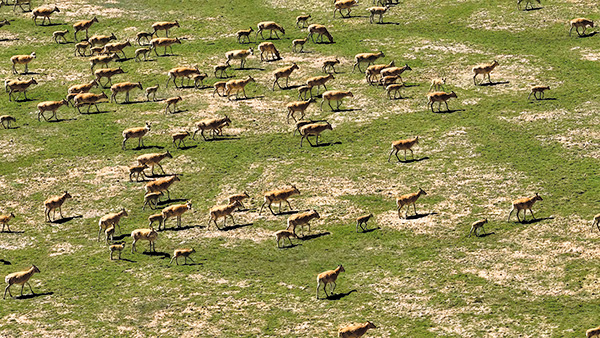
Tibetan antelopes seek new pastures.[ Photo provided to China Daily]
Every summer, thousands of pregnant antelopes return hundreds of kilometers from their scattered habitats to Zhuonai Lake, in Northwest China's Qinghai province, to give birth. The lake, located in the remote Hoh Xil region, has been dubbed a "delivery room" for the once endangered species, long studied by animal behavior researchers as an example of mass animal exodus to rival the Serengeti in Africa.
A group of scientists from Yunnan University and the Kunming Institute of Zoology, affiliated to the Chinese Academy of Sciences, spent a total of 18 months starting in early 2020 shooting a thousand hours of footage of the spectacle and other animal activities.
After six months spent in post-production, the materials were edited down into Biodiversity on Earth - Zhuonai Lake, a 57-minute documentary which has earned a score of 9.7 out of 10 in aggregate review on Bilibili, one of the country's most popular video-sharing platforms.
The documentary, produced by the team of China's second comprehensive scientific expedition to the Qinghai-Tibet Plateau, also captured a variety of other wildlife, from wandering yaks to fluffy plateau pikas and galloping Tibetan wild asses.
This is the directorial debut of Luo Jie, a 36-year-old scientist at the Kunming Institute of Zoology. A native of Kunming, the capital of Southwest China's Yunnan province, Luo developed a strong interest in nature in his childhood, recounting his obsession with programs such as Animal World, a series of remarkable longevity, broadcast on China Central Television since 1981.
Around six years ago, Luo started to combine his passion for research and film by shooting beneath the ocean while researching coral reefs and clownfish in Indonesia.
Luo recalls the experience of diving 40 meters down into the depths with a waterproof camera as dreamlike and spiritually healing.
"The water turns darker as you dive deeper. Because most underwater creatures are not afraid of humans, you can see a variety of fish swimming around you," Luo says.
This amateur experience earned Luo a chance to shoot the feature-length documentary, which aims to demonstrate the work of biodiversity conservationists on the plateau. He collaborated on the project with fellow scientist Zhang Zhigang, field work expert Wu Jun and wildlife cinematographer Zhang Chenghao.
"We take Zhuonai Lake as our 'protagonist', as it has drawn in generations of Tibetan antelopes inhabiting in multiple areas of Qinghai and the Xinjiang Uygur and Tibet autonomous regions over age-old migration routes. Why they decide to take such high risks and trek such a long distance to deliver their young is still a mystery," explains Zhang Zhigang, a microbiologist at Yunnan University.
He says that, as the route into the no man's land of Zhuonai Lake is dangerous, few people travel there, so the area is a shelter for wildlife, making it valuable for scientific research.
The team had its work cut out for it, with the dual task of filming the documentary and conducting scientific research - for example collecting Tibetan antelopes' droppings to get a clearer picture of the local ecosystem -all in an environment of extreme deprivation.